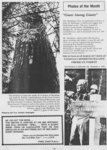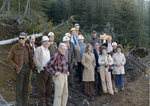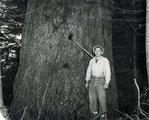


A giant Douglas fir more than 500 years old stands deep in the woods of the Crim Creek drainage area about 15 miles from Pe Ell.
It’s called the John H. Markham Tree, dedicated Nov. 4, 1976, to honor a Centralia man who cruised many Pacific Northwest forests over a career that spanned more than seven decades. At that time, the giant fir stood more than 200 feet tall (with perhaps another 100 feet that died and toppled off) with a circumference of more than 35 feet and a diameter of more than 11 feet.
Few people have seen the tree that likely sprang to life before Christopher Columbus sailed for America.
That’s something Paul Hayes of Vader wants to change.
Hayes, owner of Hayes Tree Farm near Vader, discovered the tree in 1955 while cruising the state-owned Crim Creek forest. Hayes said the McCormick Lumber Co. had logged nearby trees in the early 1900s to feed a mill in the town of McCormick, which operated from 1902 to 1927. But they left the giant standing, perhaps because it was far too large to remove with logging equipment at that time. Hayes spent two decades trying to have the giant fir protected, made available to the public, and named in honor of his mentor, John Markham.
Markham, 84, attended the 1976 dedication where a wooden plaque designating the “John H. Markham Tree” was erected at the fir’s base.
George Weyerhaeuser Jr., who worked for a summer with Markham, didn’t attend the dedication but in a letter described his mentor as “a giant in the industry equal to the Markham tree, a giant of the forest.”
A Wisconsin native, Markham grew up in Lewis County, the son of perhaps Weyerhaeuser’s first timber cruiser, Edwin D. Markham, who helped determine the location and volume of Weyerhaeuser’s 1900 acquisition of 990,000 acres from the Great Northern Railroad. John Markham, a Centralia resident who earned a forest engineering degree from the University of Washington in 1916, devoted his career to forestry and worked as the Weyerhaeuser Co.’s timber cruiser. He penned a biography called “Seventy Years in the Northwest Forests.” He died in April 1980. He and his wife, Grace, had three children, Jane, John Jr., and William.
Before he died, Markham wrote a letter to Hayes, suggesting the fir should have been named for him instead.
“You are to be thanked for your unassisted efforts over the past years in bringing to the attention of the people of Southwest Washington the fact that the one and only giant fir tree left in Southwest Washington still stands,” he wrote. “It would very likely be cut and forgotten except for your efforts.”
Not long after the dedication, the state exchanged forest property with Weyerhaeuser Co., and the Markham Tree and surrounding acreage shifted to Weyco.
Hayes, 89, a former forestlands manager for Long-Bell, International Paper and other companies and a charter member of the Lewis County Farm Forestry Association, has written letters to Weyerhaeuser officials over the past two decades urging the company to protect the tree and allow public access to see the forest giant. He said schoolchildren could learn from likely one of the oldest trees in Washington. He wants the history of the tree preserved, too, and the legacy of John Markham.
In 2000, he visited the tree with George Weyerhaeuser Jr., who told him he could ask that a 10-acre parcel be left untouched around the tree as a wind protector. Weyerhaeuser died in 2013.
Hayes has continued sending letters, making phone calls, and emailing officials at Weyerhaeuser, asking if the public can have access to the giant fir in the Pe Ell Tree Farm, perhaps even just one day a year.
The area is closed, he said, except for hunters who purchase permits. Because so many people dumped garbage on their lands, Weyerhaeuser in 2001 started locking gates to its property, and in 2014 launched a fee permit program allowing access. Recreational permits costing $300 per family allow year-round access to Weyerhaeuser lands, and people who want to hike, bike, or ride horses can pay $50 for a non-motorized permit.
Hayes finds the fees objectionable and costly, and contends the timber giant has reneged on its promise to keep the tree open to the public. He describes himself as a “completely disenchanted and disappointed stockholder.”
Two years ago, Rhonda Hunter, Weyerhaeuser’s senior vice president of timberlands, told Hayes that access to the property must be curtailed because of “operational and safety constraints.”
“You should take comfort in the fact that the tree is being preserved,” she wrote to him. “The area around the Markham tree was harvested in 2002 and the tree was left in a wildlife area.… This tree will continue to be protected as part of the wildlife area.”
The Markham Tree may not be the region’s oldest or tallest Douglas firs, but it’s among the giants. The 327-foot Doerner Fir in Coos County has been described in The Oregonian as “the world’s tallest known Douglas fir,” and the 232-foot Red Creek Fir on Vancouver Island in British Columbia is estimated to be at least 1,000 years old with a 16.5-foot diameter.
Still, it would be nice to see the Markham Tree. Perhaps Weyerhaeuser could occasionally open the site for free public access.
•••
Julie McDonald, a personal historian from Toledo, may be reached at memoirs@chaptersoflife.com. She’s also a columnist for The Chronicle. Her column appears on the Opinion page each Tuesday.